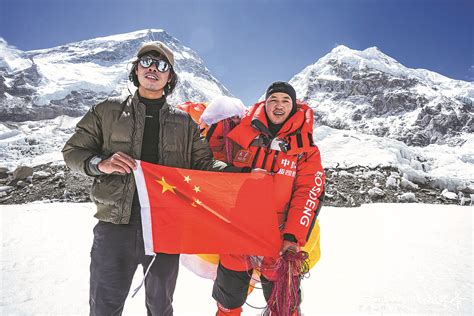
A Chinese paraglider survived an accidental ascent to 28,000 feet after being swept up by powerful thermals, enduring extreme cold and oxygen deprivation before managing a controlled descent.
A paraglider in China experienced a harrowing ordeal after being caught in unusually strong thermal currents that propelled him to an altitude of 8,500 meters (approximately 28,000 feet). The incident occurred on Sunday, May 26, 2024, at around 2:00 PM local time, turning what was intended to be a routine paragliding flight into a life-threatening situation. The paraglider, identified only by his surname, Mr. He, is an experienced paraglider. He took off from a popular paragliding spot in the mountainous region of eastern China. What began as a typical flight quickly turned perilous when Mr. He encountered unexpectedly powerful updrafts, commonly known as thermals. These thermals, columns of rising hot air, are frequently utilized by paragliders to gain altitude and extend their flights. However, on this particular day, the thermals were exceptionally strong and unpredictable.
“I’ve been paragliding for years, but I’ve never experienced anything like this,” Mr. He recounted in a later interview. “One moment, I was enjoying a normal flight, and the next, I was being pulled upwards at an alarming rate. I tried to control my glider, but the thermals were just too powerful.”
As Mr. He ascended rapidly, he quickly realized the severity of his situation. The air temperature plummeted drastically, and the oxygen level diminished significantly. At 28,000 feet, the atmospheric conditions are extremely hostile to human life. The air is thin, containing only a fraction of the oxygen available at sea level, and temperatures can drop to -40 degrees Celsius (-40 degrees Fahrenheit) or even lower.
“I started to feel the effects of the altitude almost immediately,” Mr. He explained. “My breathing became labored, and I began to feel dizzy and disoriented. I knew that if I didn’t do something quickly, I wouldn’t survive.”
Despite the extreme conditions and the rapidly deteriorating situation, Mr. He managed to maintain a degree of composure. Drawing on his years of paragliding experience and his knowledge of emergency procedures, he began to assess his options. He knew that his primary goal was to descend as quickly and safely as possible.
One of the first challenges Mr. He faced was the extreme cold. At 28,000 feet, the ambient temperature is well below freezing, and without proper thermal protection, hypothermia can set in rapidly. Mr. He was wearing standard paragliding attire, which provided some insulation but was not designed for such extreme conditions. He began to shiver uncontrollably, and his fingers and toes started to go numb.
“I knew I had to keep moving to stay warm,” Mr. He said. “I tried to wiggle my fingers and toes and to flex my muscles. I also tried to focus on controlling my glider and on finding a way to descend.”
Another critical challenge was the lack of oxygen. At 28,000 feet, the partial pressure of oxygen in the air is so low that the human body cannot function properly. The brain is particularly sensitive to oxygen deprivation, and even a brief period of hypoxia can lead to impaired judgment, confusion, and loss of consciousness. Mr. He began to experience these symptoms as he ascended.
“I started to feel like I was losing my grip on reality,” Mr. He recalled. “My thoughts became muddled, and I had trouble concentrating. I knew that if I passed out, I would be in serious trouble.”
To combat the effects of hypoxia, Mr. He tried to breathe deeply and slowly. He also focused on maintaining a positive mental attitude. He knew that if he panicked, he would only make the situation worse.
“I kept telling myself that I could do it,” Mr. He said. “I kept reminding myself of my training and of my experience. I tried to stay calm and focused.”
After what seemed like an eternity, Mr. He finally managed to regain some control over his glider. He used his control lines to initiate a controlled descent. The descent was slow and gradual, but it was enough to start bringing him down to a more survivable altitude.
As he descended, Mr. He continued to battle the effects of the cold and the lack of oxygen. He also had to contend with strong winds and turbulence. The air at lower altitudes was warmer and more oxygen-rich, but it was also more turbulent. Mr. He had to use all of his skill and experience to keep his glider stable and to avoid being thrown around by the wind.
“The descent was almost as challenging as the ascent,” Mr. He said. “I was still feeling the effects of the altitude, and the wind was making it difficult to control my glider. But I knew that I was getting closer to safety, and that gave me the strength to keep going.”
Finally, after more than an hour in the air, Mr. He managed to land his glider in a remote field. He was exhausted, cold, and disoriented, but he was alive.
“I was so relieved to be back on the ground,” Mr. He said. “I just collapsed and lay there for a few minutes, catching my breath.”
After resting for a short time, Mr. He managed to contact emergency services. He was soon rescued and taken to a local hospital for medical treatment. Doctors found that he was suffering from severe hypothermia and mild hypoxia. He was treated with intravenous fluids and oxygen, and he made a full recovery within a few days.
The incident involving Mr. He has raised concerns about the safety of paragliding in mountainous regions. Experts say that while paragliding is generally a safe activity, it can be dangerous if precautions are not taken.
“Paragliding is a wonderful sport, but it’s important to remember that it can be risky,” said a spokesperson for the local paragliding association. “Paragliders should always check the weather conditions before flying, and they should be aware of the potential for strong thermals. They should also carry appropriate safety equipment, such as a helmet, a harness, and a reserve parachute.”
The spokesperson also emphasized the importance of training and experience. “Paragliders should be properly trained before they attempt to fly in challenging conditions,” the spokesperson said. “They should also gain experience gradually, starting with easier flights and working their way up to more difficult ones.”
Mr. He’s experience serves as a stark reminder of the risks associated with paragliding and the importance of being prepared for unexpected events. His survival is a testament to his skill, experience, and mental fortitude. It also highlights the importance of having proper safety equipment and the ability to react quickly and decisively in an emergency situation.
The incident is under investigation by local aviation authorities, who are seeking to determine the precise cause of the unusually strong thermals that swept Mr. He to such a dangerous altitude. Preliminary reports suggest that a combination of factors may have contributed, including unusually warm temperatures at ground level and a strong inversion layer in the atmosphere.
An inversion layer is a layer of the atmosphere in which temperature increases with altitude, rather than decreasing as it normally does. Inversion layers can trap warm air near the ground, creating conditions that are conducive to the formation of strong thermals.
The investigation is expected to take several weeks to complete. In the meantime, local paragliding clubs have issued warnings to their members about the potential for strong thermals and the importance of taking extra precautions when flying in mountainous regions.
Despite his harrowing experience, Mr. He says that he is not deterred from paragliding. He plans to return to the sport as soon as he is fully recovered.
“I love paragliding,” Mr. He said. “It’s a challenging and rewarding activity, and I wouldn’t give it up for anything. But I’ve learned a valuable lesson from this experience, and I will be more careful in the future.”
Mr. He’s story is a remarkable tale of survival against the odds. It is a reminder of the power of nature and the importance of being prepared for the unexpected. It is also a testament to the human spirit and the ability to overcome even the most daunting challenges.
The incident also highlights the advancements in paragliding technology and safety equipment. Modern paragliders are designed to be highly maneuverable and stable, and they are equipped with a range of safety features, such as reserve parachutes and emergency locator beacons. These advancements have made paragliding a much safer activity than it was in the past.
However, even with the best equipment and training, paragliding can still be dangerous. The sport involves inherent risks, such as the potential for strong winds, turbulence, and unexpected weather changes. Paragliders must be aware of these risks and take appropriate precautions to mitigate them.
The incident involving Mr. He is a reminder that even experienced paragliders can encounter unexpected challenges. It is important for all paragliders to be prepared for emergencies and to have the skills and knowledge to respond effectively.
The local paragliding community has rallied around Mr. He, offering him support and encouragement. Many paragliders have expressed their admiration for his courage and his ability to survive such a harrowing experience.
“Mr. He is a true hero,” said one local paraglider. “He showed incredible resilience and determination in the face of extreme adversity. We are all proud to call him a member of our community.”
The incident involving Mr. He has also sparked a debate about the regulation of paragliding in China. Some people have called for stricter regulations, while others have argued that the existing regulations are adequate.
The local aviation authorities are currently reviewing the regulations to determine whether any changes are needed. They are also working with paragliding clubs to improve safety training and awareness.
The goal is to ensure that paragliding remains a safe and enjoyable activity for everyone. The incident involving Mr. He has served as a wake-up call, reminding everyone of the importance of safety and preparedness.
As Mr. He continues his recovery, he is grateful for the support he has received from his family, friends, and the paragliding community. He is also thankful to the emergency services personnel who rescued him and provided him with medical care.
He is looking forward to returning to the skies soon, but he will never forget the lessons he learned from his harrowing experience. He is determined to use his experience to help others learn about the risks of paragliding and the importance of being prepared for emergencies.
The incident involving Mr. He is a story of survival, resilience, and the importance of community. It is a reminder that even in the face of extreme adversity, the human spirit can triumph. It is also a reminder that we must always be prepared for the unexpected and that we must support each other in times of need.
The tale of Mr. He’s accidental ascent has resonated far beyond the paragliding community, capturing the attention of people around the world. His story has been shared widely on social media, and he has received messages of support from people in many different countries.
His story is a testament to the power of the human spirit and the ability to overcome even the most daunting challenges. It is also a reminder that we are all connected and that we can support each other in times of need.
As Mr. He continues his recovery, he is an inspiration to us all. He is a reminder that even when faced with seemingly insurmountable obstacles, we can find the strength to persevere and to emerge stronger than ever before.
His experience serves as a valuable lesson for all of us, reminding us to be prepared for the unexpected, to stay calm in the face of adversity, and to never give up hope. His story is a reminder that the human spirit is capable of extraordinary things and that we can all make a difference in the world.
The paragliding community is committed to learning from Mr. He’s experience and to improving safety practices to prevent similar incidents from happening in the future. They are working together to share knowledge, to promote safety awareness, and to support each other in times of need.
The goal is to ensure that paragliding remains a safe and enjoyable activity for everyone. The incident involving Mr. He has served as a catalyst for change, inspiring the community to work together to create a safer and more supportive environment for all paragliders.
Mr. He’s story is a reminder that we are all in this together and that we can achieve great things when we work together. It is a testament to the power of community and the importance of supporting each other in times of need.
He is a symbol of hope and resilience, inspiring us to believe in ourselves and to never give up on our dreams. His story is a reminder that anything is possible and that we can all make a difference in the world.
Frequently Asked Questions (FAQ):
1. What happened to the Chinese paraglider, Mr. He?
Mr. He, a paraglider in China, was caught in unusually strong thermal currents, causing him to ascend to an altitude of 8,500 meters (approximately 28,000 feet). This accidental ascent led to extreme cold, oxygen deprivation, and a life-threatening situation.
2. How did Mr. He survive at such a high altitude?
Despite the extreme conditions, Mr. He managed to maintain composure and used his paragliding experience to initiate a controlled descent. He battled the effects of cold and hypoxia, focusing on breathing deeply, staying calm, and controlling his glider.
3. What were the challenges Mr. He faced during his accidental ascent?
Mr. He faced several critical challenges, including extreme cold (temperatures dropping to -40 degrees Celsius), severe oxygen deprivation (hypoxia), and strong winds and turbulence during his descent. These conditions impaired his judgment and physical abilities.
4. What safety measures can paragliders take to prevent similar incidents?
To prevent similar incidents, paragliders should always check weather conditions before flying, be aware of the potential for strong thermals, carry appropriate safety equipment (helmet, harness, reserve parachute), and receive proper training. Gaining experience gradually is also essential.
5. What is the current status of the investigation into the incident?
The incident is under investigation by local aviation authorities to determine the cause of the unusually strong thermals. Preliminary reports suggest a combination of factors, including warm temperatures at ground level and a strong inversion layer in the atmosphere, may have contributed. The investigation is expected to take several weeks.









